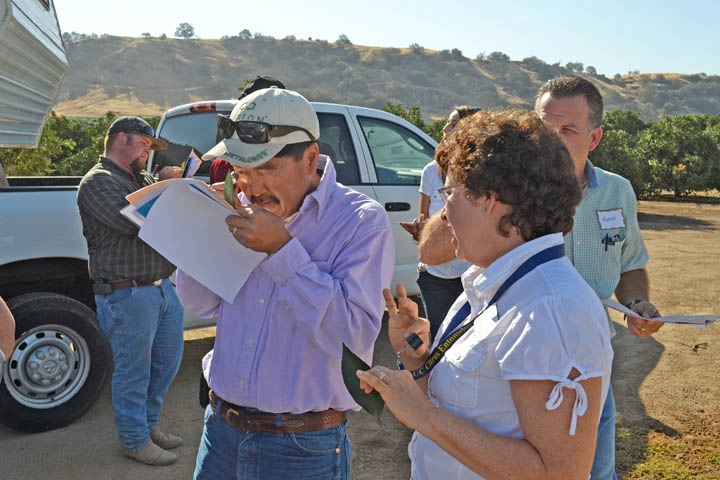September 28, 2012

Growing resistance to the organophosphate chlorpyrifos, huge populations and no natural parasites have elevated citricola scale to the No. 1 citrus pest in the San Joaquin Valley.
Its dubious distinction is no doubt why a larger-than-expected crowd showed up at the Lindcove Research and Extension Center in Exeter, Calif., to hear University of California citrus IPM specialist and research entomologist Beth Grafton-Cardwell not only talk about the pest, but show growers, PCAs and others what to look for in scouting for citricola scale.
Citricola scale is a voracious pest that in high numbers can dramatically reduce yield. A typical Valencia orange tree can produce 325 oranges per tree. If there are 10 citricola scale per twig, yields can drop by 70 fruit per tree, a yield loss of more than 20 percent.
The yield loss may be even more severe with Navel oranges and lemons, Grafton-Cardwell says.
The tiny scale also secrete honeydew that can create sooty mold on citrus. This can be washed off in the packinghouse.
Grafton-Cardwell and her crew of research technicians set up a mobile teaching lab for field day attendees to examine scales under a microscope. They also sent growers and PCAs into nearby groves in search of the not so elusive citricola scale. The research technician crew also collected scale infested leaves and distributed hand lenses to help growers identify dead and live scale on leaves.
The field day was held in mid-September, a month or so after what Grafton-Cardwell says is the prime time (late July/early August) to control the scale. This is when the first instar nymphs are on leaves and most susceptible to insecticides.
The more dead scales found, the less chance of a big outbreak next year.
The only effective control method in the valley is insecticide treatments. The parasitic wasp that is an effective biological control in Southern California citrus does not control the pest in the valley because of the high populations of scale produced under hotter valley conditions.
Citricola scales reproduce asexually allowing rapid population growth, according to the UC IPM website. It has only a single generation per year. Adults are found in the spring and early summer on twigs, and immatures are typically found underneath leaves in late summer and fall. Females produce approximately 1,000 eggs during their lifetime. Eggs hatch into mobile first instar nymphs, also known as crawlers. Crawlers relocate to find a suitable location, become fixed, then molt into second instar nymphs that produce large quantities of honeydew and are often tended by ants.
Lorsban resistance
Understanding the timing of the life cycle of the pest is critical to controlling it, Grafton-Cardwell says. If a grower thinks he will control citricola scale in the spring with his red scale spray, he is mistaken, she says.
In the spring, the egg-laying female is protecting her eggs under her body then and pesticides will not kill adults; therefore her 1,000-egg brood is not affected by the pesticide.
There is a wide array of products available for use against citricola scale, but the scale has developed resistance to one of the most popular and effective ones, Lorsban. Grafton-Cardwell says 40 percent of the valley’s citricola scale is resistant to Lorsban.
Regardless of the product selected, she says use the top label rate recommended in plenty of water to get good coverage, even as much as 750 to 1,000 gallons of water per acre if necessary to penetrate thick foliage. And slow down for best coverage.
She is evaluating new products that will be on the market over the next two years.
Oil will control citricola scale for organic growers, but it may take two applications per season.
There is a list of registered foliar and systemic compounds on the UC IPM website.
“You can make any (registered) chemistry work, if you work at it,” she says.
The first step in controlling citricola scale is to find them.
UC has developed two sampling techniques.
Sample in the northeast corner of the grove.
With a presence/absence technique, UC recommends walking down a row taking one to two fully expanded, shady leaves from the northeast corner of 25 trees (25 leaves).
Count the number of leaves with one or more live citricola scale. Ignore the dead ones.
Repeat this in three evenly spaces rows in the block.
If any of the rows have 13 or more infested leaves, treat the whole block with an insecticide this fall. If all rows are in the one to four-leaf range, wait until next season. If some rows have “consider treating” ratings, Grafton-Cardwell says “it would be wise to treat.
Another sampling method is to take one leaf from 100 trees in the northeast corner and count all live nymphs. If the number is greater than 0.5 per leaf, treat.
The females lay eggs on twigs from March to April. From May to July, the nymphs are “pretty easy to see on the twigs,” says Grafton-Cardwell. By mid-October through November the citricola scale moves back into the interior of the tree.
Grafton-Cardwell said it is relatively easy to distinguish between live and dead scale. Using a hand lens, live scale are more plump and a little more yellow than the dead scale, which are more flat than live scale.
Citricola scale is found in California and Arizona.
About the Author(s)
You May Also Like






